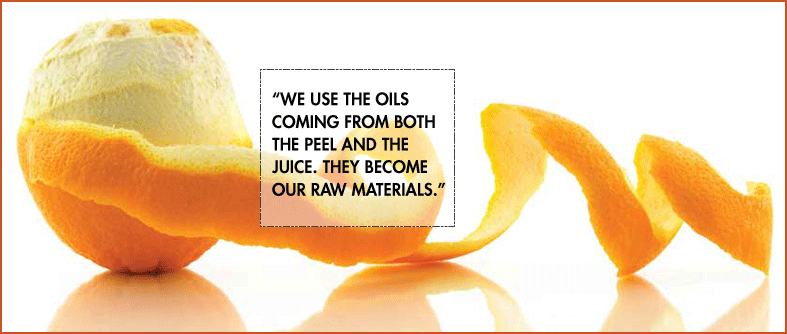| Adding freshness and flavor to otherwise ordinary items |
Your unwanted citrus peels can easily be put to good use in your garbage disposal, where they clean your blades and send a fresh fragrance throughout your kitchen. But technology has expanded the possibilities for what otherwise might be discarded. [emember_protected custom_msg=”Click here and register now to read the rest of the article!”]
Processors can chemically extract citrus oil and its components, making them into a whole host of products we find at the grocery store: hand cleaners and fresheners, furniture wax, and flea and tick shampoo. Flavorings can be added to all sorts of beverages, from orange juice to soda, and liqueur.
“The oil from the peel or the waste peel is typically sold to farmers for cattle feed,” says Mark Walsh, vice president of Takasago’s Global Citrus Platform. “We use the oils coming from both the peel and the juice. They become our raw materials.”
Walsh works in Lakeland for the Tokoyo-based Takasago, which develops and manufactures flavorings and fragrances for foods, beverages, and household care items.
About 95 percent of the citrus oil in the peel is a natural solvent, limonene, that doesn’t have much flavor or aroma. So they remove the limonene, essentially making the oil soluable. The extract can be dissolved into beverages. “That’s only one method by which we can utilize the oil,” Walsh explains. “We’ve got many different technologies we would employ.”
At Lake Alfred-based Florida Caribbean Distillers, citrus peels are used to flavor alcohol, such as their new Florida Old Reserve Orange Liqueur. The peels are added to a spirits-based solution, or a pharmaceutical food-grade ethanol, and left to soak in a huge tank for three to four weeks, says Stacy Woodward, the senior quality and product development manager who works in Auburndale.
“The longer you let it sit the more flavor or bouquet that you’re going to get,” says Woodward. “They usually have strainers in the reservoir so whatever you’re putting in there you can get that out of your tank.” While the solution soaks, a chemical reaction takes place. The ethanol soaks up the flavoring agent, whether it is orange peels, vanilla beans, or coffee beans, she says.
“We just started using orange peels a couple of years ago,” Woodward observes. The mixture is agitated to infuse air. In four to six weeks, the flavored spirits are bottled for a regional market.
CREDIT
story by CHERYL ROGERS [/emember_protected]

